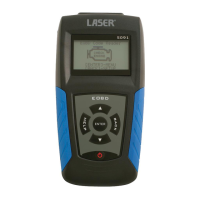Laser 5091 Code Reader User’s Guide
8
Laser 5091 Code Reader User’s Guide
9
Diagnostics – leads to OBDII screens for all 9 generic OBD system tests.
DTC Lookup – leads to screens for diagnostic trouble code lookup.
Review Data – leads to screens for access to tested data files.
Print Data – leads to screens for access to printing function
About – leads to screen that shows information about the code reader.
Setup – leads to screens for adjusting default settings to meet your own preference when
using the code reader.
Figure 3.1 Sampl
e Home Screen
4 OBDII/EOBD Operations
OBD-II/EOBD menu lets you access all OBD service modes. According to ISO 9141-2, ISO
14230-4, and SAE J1850 standards, the OBD application is divided into several sub programs,
called ‘Service $xx’. Below is a list of OBD diagnostic services:
● Service $01 - request current powertrain diagnostic data
● Service $02 - request powertrain freeze frame data
● Service $03 - request emission-related diagnostic trouble codes
● Service $04 - clear/reset emission-related diagnostic information
● Service $05 - request oxygen sensor monitoring test results
● Service $06 - request on-board monitoring test results for specific monitored systems
● Service $07 - request emission-related diagnostic trouble codes detected during current or
last completed driving cycle
● Service $08 - request control of on-board system, test or component
● Service $09 - request Vehicle Information
● Service $0A - request Emission related DTCs with permanent status
When Diagnostics application is selected from Home screen, the code reader starts to detect the
communication protocol automatically. Once the connection has established, a menu that lists all
of the tests available on the identified vehicle displays. Menu options typically include:
● Read Codes
● Freeze Frame Data
● Erase Codes
● Live Data
● I/M Readiness
● O2 Sensor Test
● On-board Monitor Test
● Component Test
● Vehicle Information
● Modules Present
● Unit of measure
NOTE:
Not all function options listed above are applicable to all vehicles. Available options may vary by
the year, model, and make of the test vehicle. A “The selected mode is not supported!” message
displays if the option is not applicable to the vehicle under test. When the code reader links to
vehicle, it checks the status of I/M Monitors automatically, and gives a summary report on the
display as illustrated below.
The following applications are preloaded into the code reader:
Figure 4-1 Sample System Status Screen
NOTE:
If vehicle is equipped with more than one computer module (for example a powertrain control
module [PCM] and a transmission control module [TCM]), the code reader identifies them by their
identification names (ID) assigned by manufacturer (i.e. Engine or Module $A4).
A screen with prompted information to erase the previously stored data in order to save the data
from this test displays as below.
Figure 4-2 Sample Erase the Previous Stored Data Screen
If previous data is to be erased, select Yes; if data is not to be erased, Use the LEFT/RIGHT key
to pick No. Wait a few seconds to return to Diagnostic Menu.
NOTE:
If no data is stored in the code reader, the above screen will not show up.
4.1 Read Codes
Read Codes menu lets you read stored codes, pending codes and permanent does found in the
control unit. Typical menu options include:
● Stored Codes
● Pending Codes
● Permanent Codes
Diagnostic trouble codes stored in a control module are used to help identify the cause of a
trouble or troubles with a vehicle. These codes have occurred a specific number of times and
indicate a problem that requires repair.
Pending codes are referred to as maturing codes that indicate intermittent faults. If the fault does
not occur wi
thin a certain number of drive cycles (depending on vehicle), the code clears from
memory. If a fault occurs a specific number of times, the code matures into a DTC and the MIL
illuminates or blinks.
Permanent Codes are DTCs that are "confirmed" and are retained in the non-volatile memory of
the computer until the appropriate monitor for each DTC has determined that the malfunction is
no longer present and is not commanding the MIL on. Permanent DTC shall be stored in

